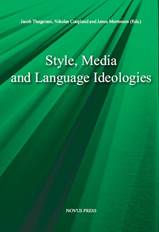Slice news letter December
Dear SLICE friends
1. The BIG good news this time is the publication of two books related to SLICE’s media strand. Make acquaintance with the contents in the editors’ letter below.
2. But first learn about another good news: Jeroen Darquennes has joined our network. He writes: “I haven't done a great deal of work on language standardization yet, but I quite recently edited a volume on the standardization of minority languages for which I invited Wim Vandenbussche as a co-editor (cf. attachments).
3. And one more: Related to SLICE’s experimental strand, Ragnhild Lie Anderson and Edit Bugge recently published the paper “Dialect and other explanatory factors in subconscious verbal guise tests” in Acta Linguistica Hafniensia 2016. The paper can be downloaded from https://www.tandfonline.com/doi/full/10.1080/03740463.2015.1110959. Edit writes that people who are interested in the paper but cannot get free access via their universities can contact her for free copies as long as she has some of those left. Edit.Bugge@hib.no
Left for votre vieux rédacteur is only to send the best of wishes for the upcoming break and the whole of 2017!
Tore
https://lanchart.hum.ku.dk/research/slice
[It seems that he SLICE 3 volume is too fresh from the printer to have appeared on the webshop link given in the editors’ letter below, so you may not be able to make it a Christmas present to yourself… but don’t you deserve to pamper yourself with a New Year present?]
Two new SLICE media books
We are happy to announce that not just one but two books related to SLICE’s media strand are now published. The books represent the material outcome of a roundtable held in Copenhagen in the summer of 2014. Both books are edited by the trio of Nik Coupland, Janus Mortensen and Jacob Thøgersen. They are clearly related, but they are also specialised:

One book, Style, Media and Language Ideologies edited by Thøgersen, Coupland and Mortensen continues the work on dialect and standard language ideologies which has been a core interest of the SLICE network since its start. The book is published on Novus Press: http://novus.mamutweb.com/Shop/Search?q=style&page=1) as volume 3 in their “Standard Language Ideology in Contemporary Europe” (aka SLICE) series. In due time we hope to be able to make the manuscript openly available on the SLICE website in the way the first two books are: https://lanchart.hum.ku.dk/research/slice/publications_and_news_letters/publications/.
The book contains the following chapters:
Nikolas Coupland, Jacob Thøgersen and Janus Mortensen
Introduction: Style, media and language ideologies
Jane Stuart-Smith
Bridging the gap(s): The role of style in language change linked to the broadcast media
Jan-Ola Östman
Styling street credibility on the public byways: When the standard becomes ‘the dialect’
Jacob Thøgersen
The style and stylization of old news reading in Danish
Agnete Nesse
Kallemann and Amandus: The use of dialect in children’s programmes on early Norwegian radio
Sarah Van Hoof and Jürgen Jaspers
Negotiating linguistic standardization in Flemish TV fiction around 1980: Laying the grounds for a new linguistic normality
Leonie Cornips, Vincent de Rooij, Irene Stengs and Lotte Thissen
Dialect and local media: Reproducing the multi-dialectal hierarchical space in Limburg (the Netherlands)
Pia Quist
Representations of Multi-ethnic youth styles in Danish broadcast media
Allan Bell
‘An evil version of our accent’:Language ideologies and the neighbouring other
Nikolas Coupland
Dialect dissonance: The mediation of indexical incoherence

Style, Mediation, and Change
global.oup.com
Technologically mediated talk is organized around familiar styles-styles of person, relationship and genre. But media also consistently remake and re-style these familiar patterns. This book brings together original research on media styling in different national contexts and languages, written by authors at the forefront of sociolinguistic research on mediated talk. It highlights and theorizes how creative acts of mediated styling can promote social and sociolinguistic change.
The other book, Style, Mediation and Sociolinguistic Change – Sociolinguistic Perspectives on Talking Media edited by Mortensen, Coupland and Thøgersen takes a broader look at style and stylisation in media performances; not just those related to standard languages and dialects but to style in a wide variety of senses. The book is published by Oxford University Press in their “Oxford Studies in Sociolinguistics” series. (Link directly to the book: https://global.oup.com/academic/product/style-mediation-and-change-9780190629496?q=style%2C%20mediation&lang=en&cc=dk and: https://global.oup.com/academic/product/style-mediation-and-change-9780190629489?q=style%2C%20mediation&lang=en&cc=dk)
The book contains the following chapters.
Janus Mortensen, Nikolas Coupland and Jacob Thøgersen
Conceptualizing style, mediation and change
Nuria Lorenzo-Dus
Style, sociolinguistic change and political broadcasting: The case of the Spanish news show Salvados
Tereza Spilioti
Bilingual talk on radio pranks: Styling national identity at times of crisis
Nikolas Coupland
Styling syncretic bilingualism on Welsh-language TV: Madamrygbi The business of style – the style of business
Helen Kelly-Holmes
Brand styling, enregisterment, and change: The case of C’est Cidre
Monika Bednarek
(Re-)circulating popular television: Audience engagement and corporate practices – with special focus on The Big Bang Theory.
Joanna Thornborrow
Styling the ‘ordinary’: Tele-factual genres and participant identities
Adam Jaworski
Art on television: Television as art
Martin Montgomery
Talking for fun and talking in earnest: Two styles of mediated broadcast talk
Theo van Leeuwen
The meaning of manner: Change and continuity in the vocal style of news reading and information announcements
Jannis Androutsopoulos
Style, change, and media: A postscript
Nikolas Coupland and Janus Mortensen
Style as a unifying perspective for the sociolinguistics of talking media
We, the editors, want to express our gratitude to the contributors to the two volumes for their time, energy, enthusiasm, and patience with the books. We know it has at times been a frustrating process, but we hope the final results make up for inconveniences. Your authors’ copies are in the mail. If you haven’t received them yet, they should arrive soon.
The_standardisation_of_minority_language.pdf
Sociolinguistica 29_ToC.pdf
